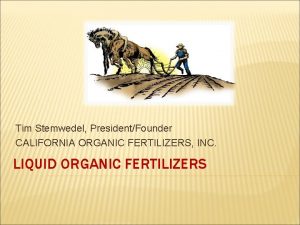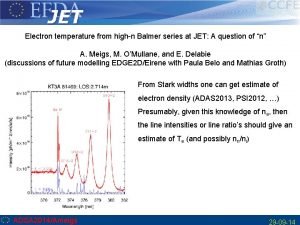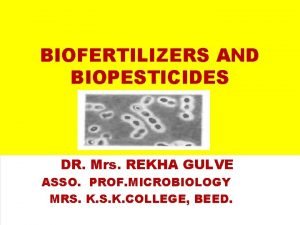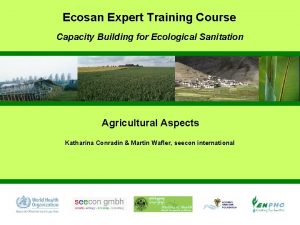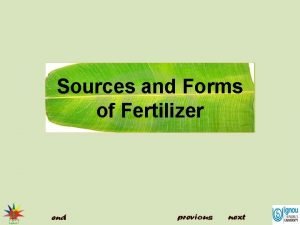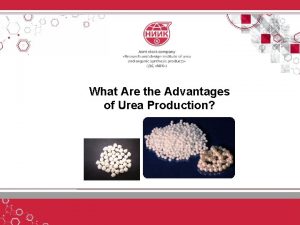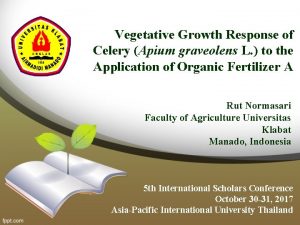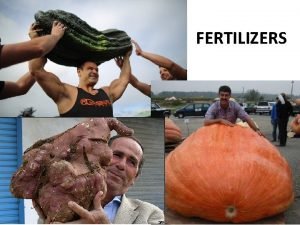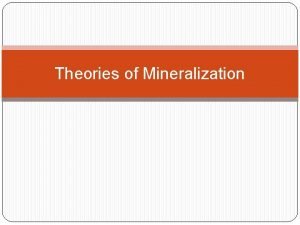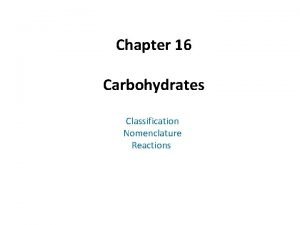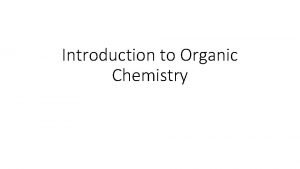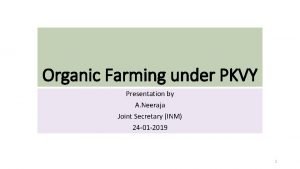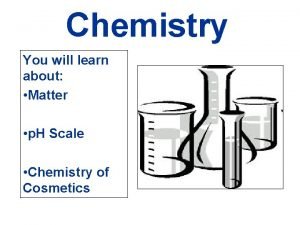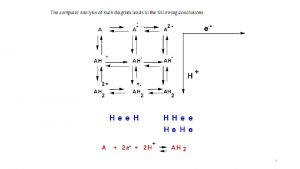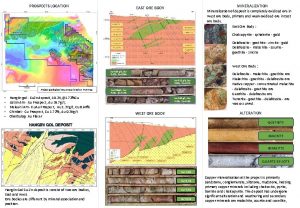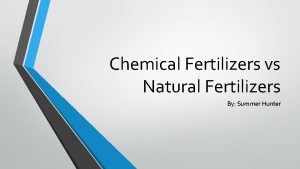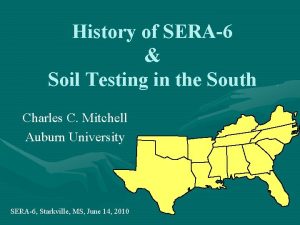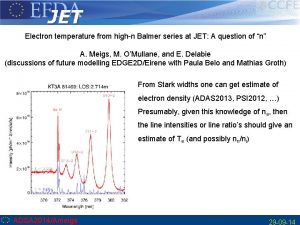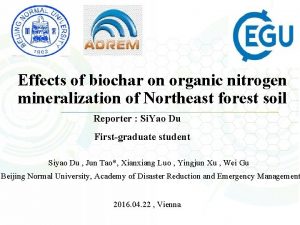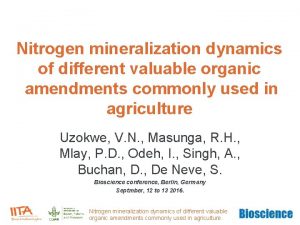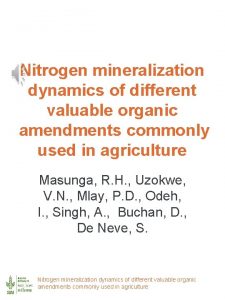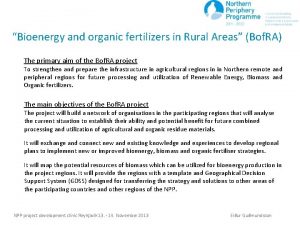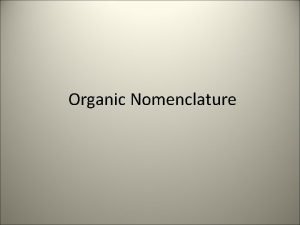Mineralization of highN organic fertilizers SERA6 2012 L



















- Slides: 19

Mineralization of high-N organic fertilizers SERA-6 2012 L. Sonon, D. Kissel, U. Saha, and SPW Lab Staff Agricultural and Environmental Services Labs. University of Georgia 2400 College Station Road Athens, GA

FACTS ABOUT ORGANIC FOOD PRODUCTION • Organic foods – fastest growing sector of agriculture. • Growth in sales ~20% per year. • Increasing acreage converted to organic farming. http: //www. ers. usda. gov/media/185272/eib 58_1_. pdf http: //www. osmoorganics. co. uk/start/fertilizer s_bio/en http: //www. smilinggardener. com http: //www. nal. usda. gov/afsic/pubs/ofp. shtml http: //organic. colostate. edu/documents/Thilmany_paper. pdf y n a p r Com elling e z i l i ert h S t F i c i W n Orga onnection f O t den n C l i I s s . htm d e r u Farm P press a. c a r i r le n e F typ Form Guilty To r To Or 02 g_2 a 8_townsley. guil s 12_ ze Plead tic Ferot/cialni/news/2012/20 e sa Synth ustice. gov/u w. j //ww http: //www. alibaba. com/productfree/110365349/Durabloom_Bio_Organic_Fertiliz er

Objective Determine the N mineralization of high-N organic fertilizers applied to a low organic matter and sandy Georgia soil. Table 1. Chemical characteristics and particle size analysis of soil used in the study. Mehlich I Extractable Nutrients, mg kg-1 p. HCa. Cl 2 4. 80 P K Ca Mg Mn Zn Total, % C N % Sand Silt Clay OM -----%----- 58 140 450 80 115 8 0. 433 0. 028 0. 97 76 12 12

Methods Three high-N organic fertilizers: • Blood Meal: 15. 53% N • Bone Meal: 9. 29% N • Feather Meal: 13. 95% N

Table 1. Initial concentrations of total carbon (C), total N, C: N, extractable NH 4 -N and NO 3 -N, and total P and K in organic fertilizers. Total C Total N C: N Fertilizer % % Extr. NH 4 -N Extr. Total P NO 3 -N mg kg-1 % % Total K Feather Meal 49. 43 13. 95 3. 11 301 1. 91 0. 26 0. 08 Bone Meal 42. 61 9. 29 4. 59 38 3. 49 4. 21 0. 66 Blood Meal 49. 24 15. 53 3. 18 256 0. 94 0. 15 0. 41

• Rate of application: 200 kg N/ha or 100 mg N/kg soil • Moisture condition during incubation: 70% field capacity • Incubation time (d): 3, 8, 15, 24, 31, 52, 80, 95

Incubation Experiment Containers were covered with lids with 0. 4 cm hole cut in the center. The hole was plugged with cotton ball and a parafilm was stretched over the lid to minimize water loss but allow gas exchange during incubation. Moisture content of incubated soil/organic fertilizer was maintained at 70% field capacity throughout the incubation by adding water after weighing the jars.

Measurements done every sampling: • • • NH 4 -N NO 3 -N Total C Soil p. H

Nitrogen Mineralization Net N mineralized calculated by subtracting the total mineralized N (NH 4++NO 3 -) in soil (control) from the total mineralized N (NH 4++NO 3 -) in soil/organic fertilizer mixtures at the time of sampling divided by the original amount of total N in organic fertilizer: % Nmin = [(Nt-Ct)/No] x 100 Nmin = N mineralization in organic fertilizer; Nt = mineral N (NH 4+-N + NO 3 --N) from organic fertilizer and soil mixture at sampling time, t; Ct = mineral N (NH 4+-N + NO 3 --N) from soil alone (control) at sampling; No = initial concentration of total N in organic fertilizer. The resulting N mineralization indicates the percentage of organic N mineralized from organic fertilizer alone after incubation of soil-organic fertilizer mixture at 23 o. C.

Results

70 Contol • Bone meal treatment showed higher NH 4 in the early stages of incubation. 60 NH 4 concentration (mg/kg) • Feather meal and blood meal followed similar ammonification pattern, NH 4 peaked at 31 d after incubation. Feather Bone 50 Blood 40 30 20 10 0 3 8 15 24 31 Incubation time (d) 52 80 95

NO 3 -N in soils applied with organic N fertilizers 80 Control • Nitrification was evident on day 52, and peaked on the day 95. NO 3 -N concentration (mg/kg) 70 Feather Meal Bone Meal 60 Blood Meal 50 40 30 20 10 0 3 8 15 24 31 52 Incubation time (d) 80 95

Mineralized N (NH 4+NO 3) at various incubation times. 80 Feather Meal 70 N mineralized (%) • Total N availability (NH 4 -N and NO 3 -N) was relatively high (48%) on day 31 for feather meal and blood meal, but decreased on days 52 and 80 likely due to immobilization. • Nmin was highest on day 95, ~63% for feather meal and ~67% for blood meal. • N min from bone meal started earlier (day 15) at about 36% and gradually increased to about 48% on day 95. Bone Meal Blood Meal 60 50 40 30 20 10 0 3 8 15 24 31 52 Incubation time (d) 80 95

Ammonium and nitrate in treated soils 60 NO 3 -N 50 Concentration (mg/kg) • Nitrogen loss can be substantial if optimum crop uptake does not coincide with the peak release of N, and nitrate leaching is an important avenue of loss if excessive rain or irrigation is applied. NH 4 -N 40 30 20 10 0 3 8 15 24 31 Incubation time (d) 52 80 95

Mineralized N (NH 4+NO 3) at various incubation times. 80 Synchronizing N mineralization from organic fertilizers to provide or maintain adequate N availability for crop production. N mineralized (%) 70 60 50 Feather Meal 40 Bone Meal 30 Blood Meal 20 10 0 3 8 15 24 31 52 Incubation time (d) 80 95

Changes in nitrogen forms in control soils at various times of incubation. 18 0. 035 NH 4 -N NO 3 -N Total N 0. 030 14 0. 025 12 10 0. 020 8 0. 015 6 0. 010 4 0. 005 2 0 0. 000 3 8 15 24 31 Incubation time (d) 52 80 Total N (%) Concentration (mg/kg) 16

Soil p. H after each incubation time 6. 00 Soil p. H • Soil p. H generally decreased with incubation. Sharp decrease in p. H was noted on day 52 perhaps due to nitrification. 5. 50 5. 00 Control Feather 4. 50 Bone Blood 4. 00 3. 50 3 8 15 24 31 Incubation time (d) 52 80

Summary • Nitrogen mineralization from bone meal was slightly faster than from feather meal and blood meal (within 3 days). The practical significance of this observation can be used on appropriate timing of organic fertilizer application to coincide N needs of growing plants. • Nitrification was highest after 80 days of incubation. Without nitrate sink, leaching loss may become an issue when there’s excessive rain or irrigation. Under anaerobic condition, nitrates could denitrify.

• Given the low p. H and sandy loam texture of soil used in this study and within the 95 -d incubation period, mineralization was approximately 48% for bone meal, and about 68% for feather meal and blood meal. • What’s next?
 California organic fertilizers, inc.
California organic fertilizers, inc. Ameigs
Ameigs Dr gulve
Dr gulve Advantages of fertilizers
Advantages of fertilizers Sources of fertilizers
Sources of fertilizers Matix fertilizers
Matix fertilizers Threshold limit value of ammonia
Threshold limit value of ammonia A candy manufacturer wants to test consistency
A candy manufacturer wants to test consistency Conclusion of fertilizers
Conclusion of fertilizers What are fertilizers
What are fertilizers In urea nitrogen is present in which form
In urea nitrogen is present in which form Dr nutrition
Dr nutrition Artificial fertilizer meaning
Artificial fertilizer meaning Theories
Theories Maltose and cellobiose difference
Maltose and cellobiose difference Transition state energy diagram
Transition state energy diagram Organic chemistry
Organic chemistry Leaving group ability
Leaving group ability Organic farming
Organic farming Mixtures of organic substances and a medicinal agent are:
Mixtures of organic substances and a medicinal agent are:
